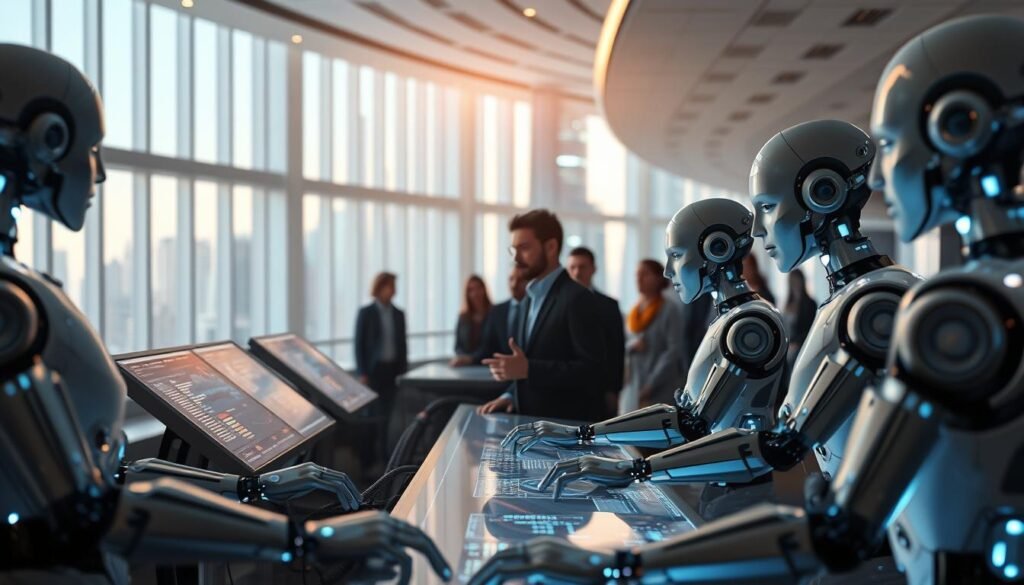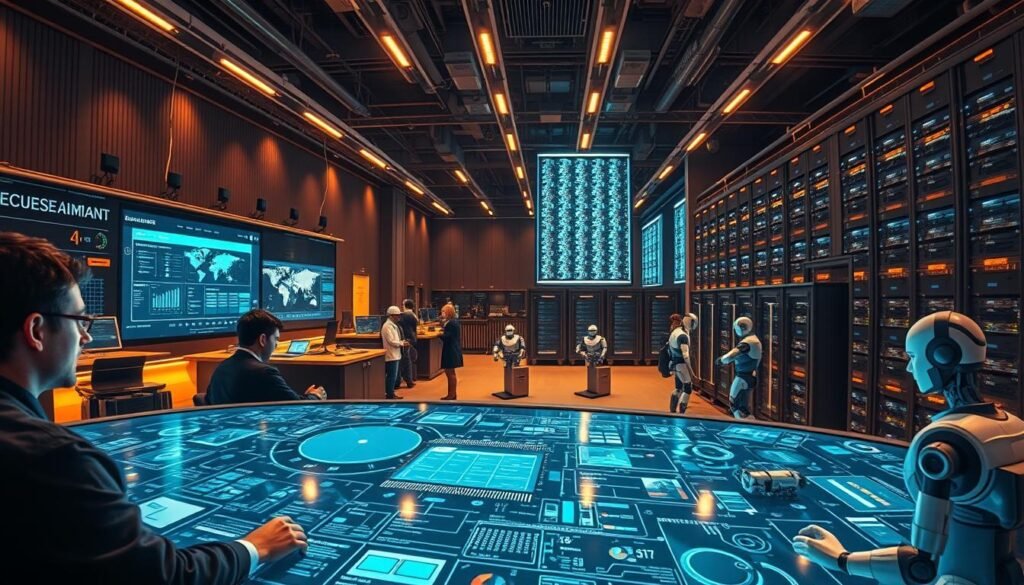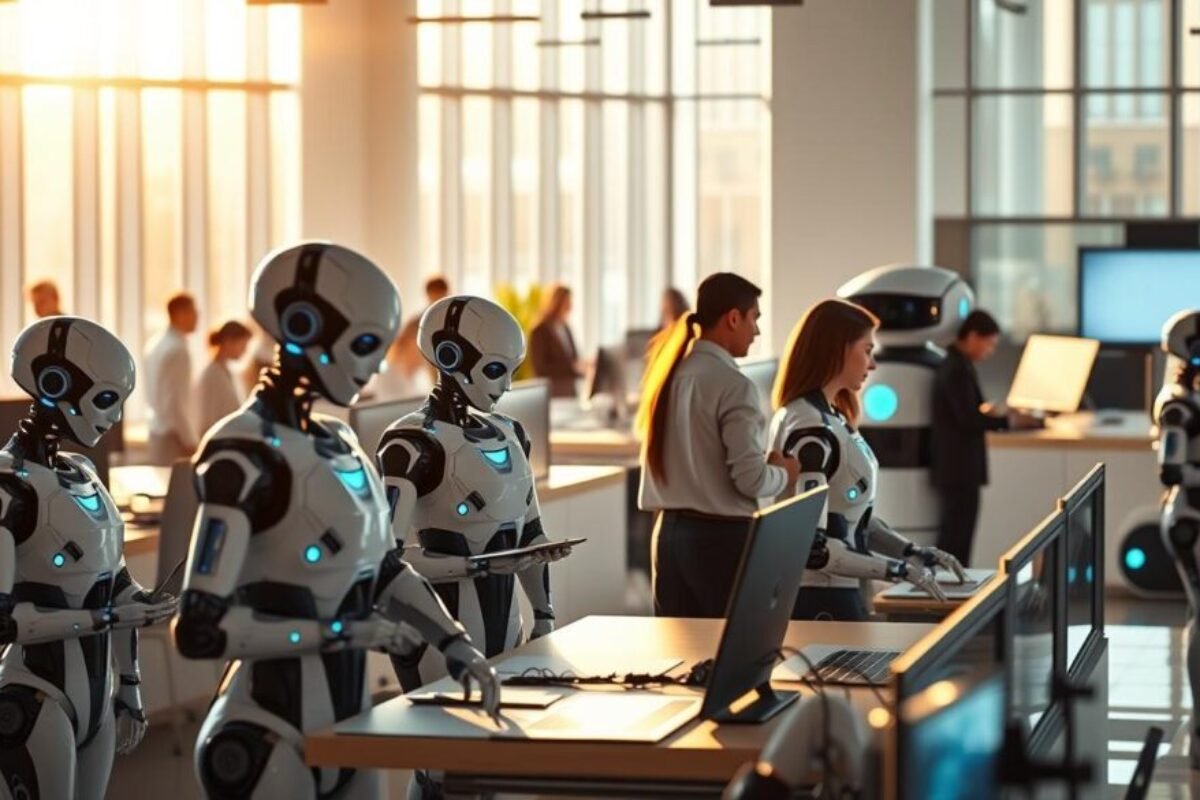The Rise of “AI Agents” and Hybrid Workforces: What Does it Mean for the Future of Work?
Did you know that up to 300 million jobs worldwide could be automated by AI, according to Goldman Sachs? This shows how fast AI Agents are changing the workplace. They’re not just doing simple tasks anymore. They’re becoming key team members in our daily work.
Leaders like Marco Argenti and Goldman Sachs say AI is key to this change. It makes work more efficient but also brings new challenges. We need new ways to work with AI Agents in our teams.
Key Takeaways
- AI Agents are expected to automate up to 300 million jobs globally.
- The transition to hybrid workforces involves AI Agents working alongside human teams.
- Major industry leaders advocate for the integration of AI in organizational structures.
- AI Agents are not just tools but integral parts of modern work environments.
- New strategies are critical for integrating AI into corporate culture and operations.
Introduction to AI Agents in the Modern Workforce
Artificial intelligence is changing the business world. Intelligent virtual agents and cognitive computing agents are key parts of the modern workforce. They use machine learning and advanced algorithms to automate tasks, making work more efficient and productive.
By adding intelligent virtual agents to our work, we see AI’s power. These agents handle tasks like customer service and data analysis. They make workflows better and cut down on mistakes. This mix of human and AI boosts creativity and strategy.
Cognitive computing agents also help drive innovation at work. They quickly and accurately analyze big data, giving insights that humans would take a long time to find. This helps teams make quick, informed decisions, keeping them ahead in the game.
As we use more intelligent virtual agents, the modern workforce is changing. AI and humans working together make work better and open up new opportunities for growth and innovation.
| Aspect | Human Workforce | AI Agents |
|---|---|---|
| Efficiency | Variable, based on skill and experience | Consistently high with accurate programming |
| Innovation | Creative problem-solving, human insight | Data analysis, pattern recognition |
| Scalability | Limited by human resources | Highly scalable based on computing power |
| Error Rate | Prone to human error | Minimized with robust algorithms |
Evolution from Hybrid Workplaces to Hybrid Workforces
The move from hybrid workplaces to hybrid workforces is a big change. It brings AI and human workers together in a new way. This change is not just about how we work but also how we see our work culture. This article will explore this shift and its key benefits.
Understanding the Transition
The change from old hybrid workplaces to new hybrid workforces adds AI to our daily tasks. This lets humans and machines work together smoothly. It makes our work teams more flexible and efficient.
With AI handling simple tasks, we can focus on harder work. This makes businesses run better and faster.
Key Benefits of Hybrid Workforces
Hybrid workforces bring many good things. First, they can change fast to meet new market needs. This gives them agility.
Second, AI lets businesses grow without needing more people. Third, working with AI makes teams more creative. This leads to happier workers who do more interesting tasks.
The Role of AI Agents in Automating Repetitive Tasks
AI agents are great at automating tasks that take up a lot of time. They handle tasks that used to take up a lot of employee time. This lets businesses use smart chatbots and other tech to free up people for more creative work.
This change is key for companies wanting to stay efficient and productive. It helps them keep improving how they work.
Reducing Busy Work with AI
Using AI for tasks cuts down on busy work in many areas. AI does things like data entry, scheduling, and answering customer questions. This frees up people to do more important tasks that need creativity and problem-solving.
Increasing Efficiency and Productivity
Task automation is more than just giving work to AI. It makes workflow better. AI makes processes smoother, cuts down on mistakes, and keeps things consistent.
This leads to better performance for both individuals and teams. By using AI, companies can make sure everyone is doing work that matters.
“Utilizing AI for repetitive tasks is akin to adding a turbocharger to our productivity engine. It’s transformative, resourceful, and inevitably forward-thinking.” – Jed Kolko, Chief Economist, indeed
AI Middle Managers: Orchestration and Oversight

AI middle managers, also known as AI Agent Orchestrators, have changed how we manage AI. They coordinate different AI agents to work together smoothly. This makes AI systems in organizations perform better.
Their role is key to keeping AI operations running well.
What Are AI Middle Managers?
AI middle managers are essential in AI management. They manage the work of specialized AI agents. This ensures these systems work together to meet company goals.
Using AI Agent Orchestrators, businesses can make processes simpler. They can also make better decisions and work more efficiently.
Case Study: Databricks and AI Agent Orchestrators
Databricks is a great example of using AI Agent Orchestrators well. They have made their virtual training programs much more efficient. This shows how AI management can improve operations.
The AI middle managers at Databricks show the great benefits of advanced AI management.
AI Agents on the Company Organization Chart
AI agents are now part of our daily work. They are not just ideas but real helpers in our jobs. We need to change how we work together with AI to make things better.
Integration and Representation in the Org Chart
AI agents are taking on roles in our teams. We need to update our charts to show their place. They help with big decisions, manage projects, and analyze data.
Having AI agents on our charts shows their real value. It’s not just about them being there. It’s about what they do to help us.
We must define what AI agents do and who they report to. They can handle simple tasks, letting humans focus on big ideas. This mix of human and AI makes work more efficient and creative.
The First Day with an AI Agent Colleague
Picture a new employee starting with an AI agent as a coworker. This is happening more often as companies use AI more. Our teams now have both humans and AI working together.
New employees need to learn how to work with AI. AI can help with setting up, training, and answering questions. This mix of human and AI skills makes work better for everyone.
Our workplaces are changing because of AI. We can do more with less effort. It’s important to use AI wisely in our teams. This way, we can all do our best work together.
Holistic Approach to Deploying and Managing AI Agents

In the world of artificial intelligence, a holistic strategy is key. It must match the goals of the organization. This means teams from IT, HR, and other areas work together. They manage AI agents well.
Cross-functional Teams for AI Agent Management
Managing AI agents is a team effort, not just for IT. A cross-functional approach brings together different skills. IT sets up the tech, HR handles training, and business units decide how to use AI.
This way, AI agents work smoothly without upsetting the team. It’s all about teamwork and making sure AI fits in well.
NVIDIA’s Prediction: IT as the Future HR of AI agents
NVIDIA thinks IT might become like HR for AI. They see IT handling AI setup, training, and updates. This fits with a holistic strategy, showing the value of teamwork.
By working together, teams and AI agents can boost innovation and efficiency. It’s all about collaboration and making things better for everyone.
Addressing the AI Gender Gap in the Workforce
The AI gender gap is a big challenge for a balanced and inclusive workforce. Fewer women are in AI roles compared to men. We need to use many strategies to increase diversity in AI.
“Diversity is not about how we differ. Diversity is about embracing one another’s uniqueness.” – Ola Joseph
Starting diversity in AI with education and training is key. We should offer programs that encourage women to join AI. Companies like Google and IBM are helping with scholarships and AI boot camps for women.
Having equal access to AI resources is also important. We need to make sure everyone can use AI tools and platforms. This makes opportunities in AI more open to all.
It’s also vital to tackle data privacy and AI trust issues, mainly for diverse groups. We must be open and have strong data rules. This builds trust and gets more people involved in AI.
In summary, solving the AI gender gap needs a mix of education, access, and trust. By doing this, we welcome more diverse talent into AI. This boosts innovation and makes AI more inclusive.
AI-Powered Personalization of Employee Experience

In today’s fast-changing workplace, AI is changing how companies improve the employee experience. Advanced technology lets companies tailor training, development, and daily tasks to each person’s likes and performance. This makes the workforce more engaged and productive.
Personalization Trends in the Workplace
AI helps us make choices based on employee data. A new trend is using AI to suggest skills, work-life balance, and career paths. This personal touch boosts morale and aligns personal goals with company goals.
Examples: Wiley and ING
Companies like Wiley and ING are leading in using AI for employee experiences. Wiley uses AI to improve onboarding, matching new hires with the right mentors and resources. ING customizes management messages, making employees feel valued and engaged. These examples show how AI can really make a difference.
“At Wiley, we believe that AI-driven personalization helps new hires feel more connected and supported from their very first day, which is key for long-term engagement.” – Wiley HR Team
| Company | AI Application | Outcome |
|---|---|---|
| Wiley | Onboarding Personalization | Enhanced employee engagement and quicker acclimation |
| ING | Management Communication Customization | Improved satisfaction and tailored employee interactions |
AI Agents as Catalysts for Business Transformation
AI agents are key players in changing businesses. They make old ways of doing things better and open up new paths. This makes AI a must-have for companies wanting to stay ahead.
Boosting Revenue and Reshaping Industries
In many fields, AI agents help grow revenue. They improve forecasting, talk to customers better, and make supply chains work smoother. For instance, AI helps companies manage stock and respond quickly to demand.
AI has changed healthcare, retail, and finance by making services more personal. This lets businesses meet market needs better, starting a new chapter in business change.
Creating New Business Models
AI agents can handle lots of data, opening up new business ideas. Companies can now offer subscription services, create products based on data, and improve customer service with AI. These new ideas bring in more money and make businesses more diverse.
For example, Netflix and Spotify use AI to suggest content that fits what customers like. This makes customers happier and keeps them coming back. It also helps these companies grow and sets new standards in their fields.
Using AI agents in business plans also leads to new, bold ideas. From digital helpers that change customer service to AI tools for marketing, the future looks bright. AI is becoming a key to success in business.
| Industry | AI Application | Impact |
|---|---|---|
| Healthcare | Patient Data Analysis | Improves diagnosis accuracy and patient care |
| Retail | Customer Behaviour Insights | Enhances personalized shopping experiences |
| Finance | Fraud Detection Algorithms | Reduces financial losses and enhances security |
| Media | Content Recommendations | Increases user engagement and retention |
Case Study: AI Agents in Software Development
AI has changed how we handle complex coding tasks and manage project timelines. It helps organizations work faster and more efficiently. This means they can get new software to market quicker.
Productivity and Speed-to-Market Improvements
AI agents make a big difference in software development. They automate tasks like code generation and testing. This lets developers focus on the creative parts of their projects.
For example, Microsoft and Google use AI to make code reviews and bug fixes faster. This cuts down development time a lot.
Impact on IT Backlogs
Dealing with IT backlogs is a big challenge in software development. AI helps by managing resources and workflows better. This makes projects more efficient.
IBM has seen huge improvements in IT efficiency thanks to AI. Their tools use data to sort and prioritize tasks. This makes managing projects easier and more effective.
Case Study: AI Agents in Customer Engagement
AI has changed how businesses talk to their customers. AI agents in contact centres make customer service better and faster. They work across different platforms, giving customers quick and accurate answers.
Omnichannel Contact Centres and Personalization
AI agents make contact centres better by giving consistent, personal experiences. They work on phone, email, chat, and social media. This way, companies can understand what customers need right away.
Customers feel more connected and happy when they get what they want. This makes them more likely to stay with a brand.
Ensuring Responsible AI and Governance
As AI becomes more common in customer service, good AI rules are key. These rules make sure AI is fair and open, keeping customer trust. They protect data, check for bias, and follow laws.
Companies that focus on responsible AI show they care about fairness and honesty. This helps them avoid problems and keep customer trust.
Preparing the Workforce for AI Agents

As we bring AI agents into our teams, it’s key to get our employees ready to work with them. Good AI training is essential. It gives our team the skills and knowledge they need to work well with AI.
Training Programs for Employees
Our AI training should cover a lot. It should go from the basics of AI to how to use it at work. This helps employees get the most out of AI in their jobs. The training should include:
- Introduction to AI and its capabilities
- Hands-on tutorials on working with AI agents
- Case studies and real-world applications
Change Management and Adoption Challenges
Switching to a workforce with AI needs big changes. We must overcome resistance to these changes. This makes sure AI is welcomed and works well.
We need to talk openly about any worries, like losing jobs or new ways of working. This helps everyone feel more comfortable and ready for change.
Also, we must have a clear change plan. This includes:
- Communication plans to inform and educate employees
- Stakeholder engagement to align organizational goals
- Continuous feedback mechanisms to monitor and address issues
By tackling these challenges, we can make our workforce more ready for the future. They will see the good things AI can do.
AI-Augmented Intelligence: Beyond Automation
In today’s work world, AI-augmented intelligence does more than just automate tasks. It helps companies use advanced data analysis and predictive insights. These tools improve decision-making, making human intelligence even stronger and changing industries for the better.
Capabilities of AI Agents
AI agents have abilities that go beyond simple automation. They can process data in real-time, create insights from huge datasets, and predict future trends. This helps businesses make smart choices, run smoothly, and stay ahead of market changes.
Collaboration and Oversight by Human Leaders
For AI-augmented intelligence to work well, humans and AI must work together. Leaders are key in making sure AI fits with company goals and follows ethical rules. By guiding and watching over AI projects, leaders can get the most out of them while avoiding risks.
AI in Retail: Scaling Efficiency and Innovation
In the fast-changing retail world, AI is changing how businesses work and grow. By using centralized AI strategies, stores can work better and make big steps forward in many areas.
Building a Centralized AI Hub
Creating a centralized AI hub is key for AI success in retail. This hub is the centre for all AI efforts, helping to manage and improve AI processes. Big names like Walmart and Amazon show how these hubs can make operations smoother, better connect data, and find new chances in the market.
Reorganizing for AI-Power Benefits
Using centralized AI strategies means changing how a company is set up. AI needs more than just new tech; it also needs a new company culture. Stores like Target and Best Buy have seen the good side of changing their setup for AI. They’ve created special AI teams, trained staff better, and made a team effort between humans and AI. The aim is to use AI to reach new heights of efficiency and innovation, helping stores stay ahead in a tough market.
Future Implications for Business Leaders
The world of AI is changing fast. Business leaders need to stay ahead by planning for the future. By focusing on strategic AI integration, they can gain big advantages and lead in innovation.
Metrics for AI Agent Effectiveness
To measure AI success, we need clear metrics. These should include how much AI improves productivity and cuts costs. They also should look at how AI affects employee happiness and work efficiency. Using these metrics helps us see if our AI plans are working well.
Strategic Questions for Leaders
Leading in AI means always asking important questions. These questions help shape our AI plans for the future. Key ones include:
- How do we balance AI-driven automation with human oversight to maintain ethical standards?
- What infrastructure upgrades are needed to support robust AI deployment?
- How can we foster a culture of continuous learning to adapt to AI-driven changes swiftly?
Answering these questions helps us lead in AI responsibly and innovatively.
Conclusion
As we explore the future of work with AI, we see both great opportunities and big challenges. AI can make work more efficient and creative. It can also change how businesses work and are structured.
AI can handle routine tasks, freeing up time for more important work. It can even make work more personal for employees. Companies like Databricks and ING are leading the way in using AI to improve work.
But we must handle AI’s challenges carefully. This includes making sure it’s used ethically and training people well. With the right approach, we can make the most of AI in our work.
In the end, the future of work with AI looks bright. But we need to do it right. We must focus on using AI in a way that’s fair and beneficial to everyone. By doing this, we can create a work environment where humans and AI work well together.




